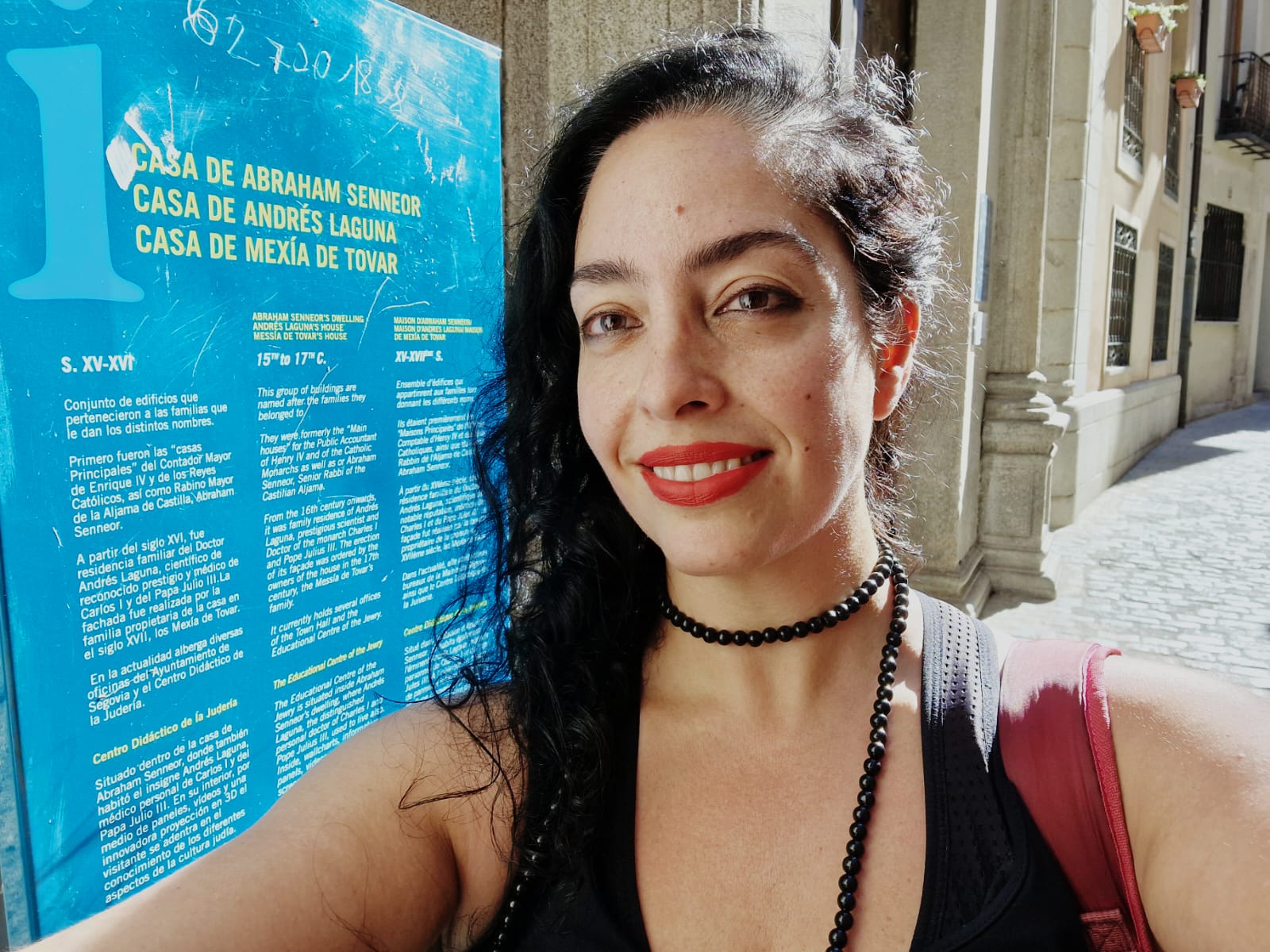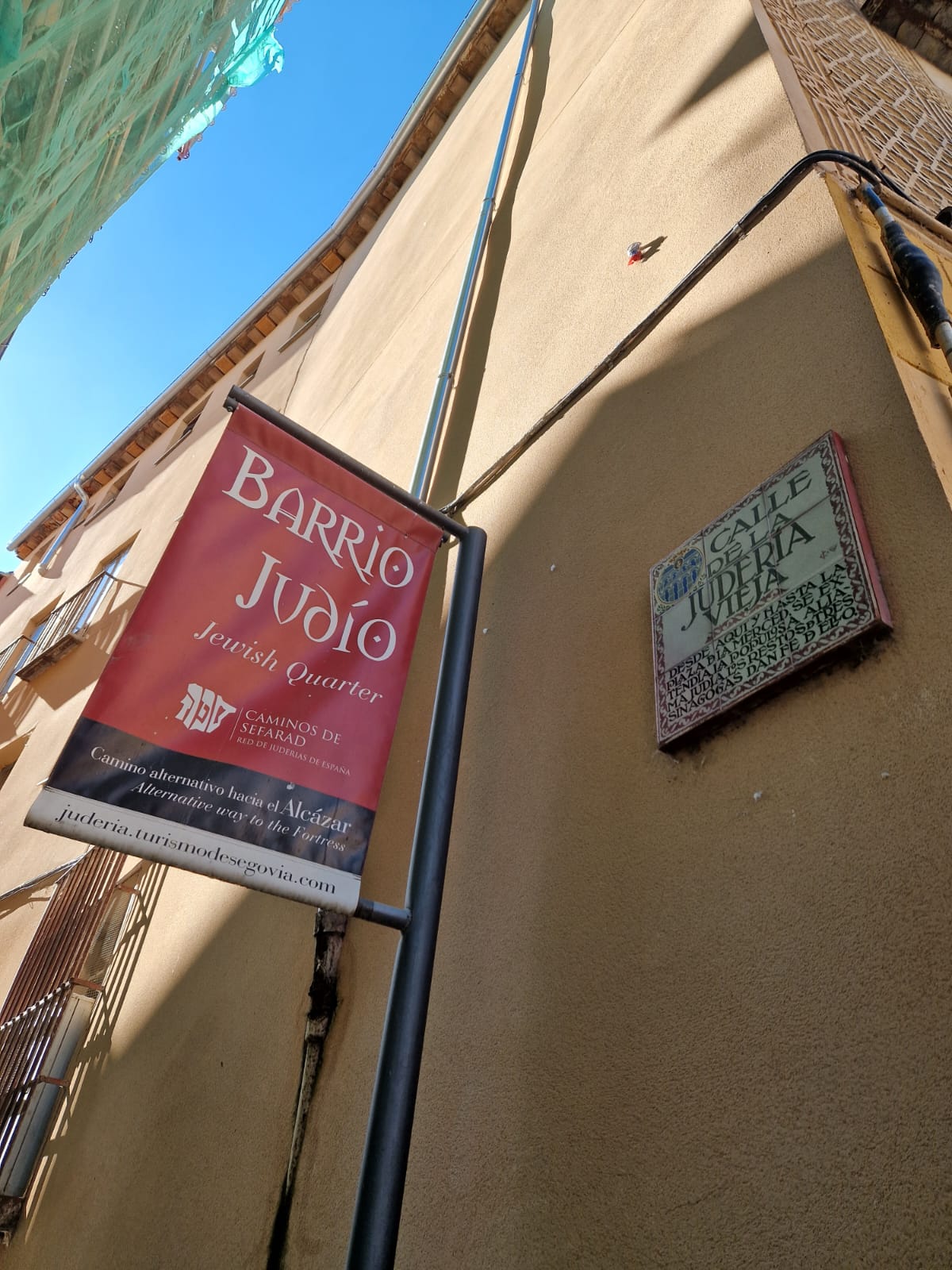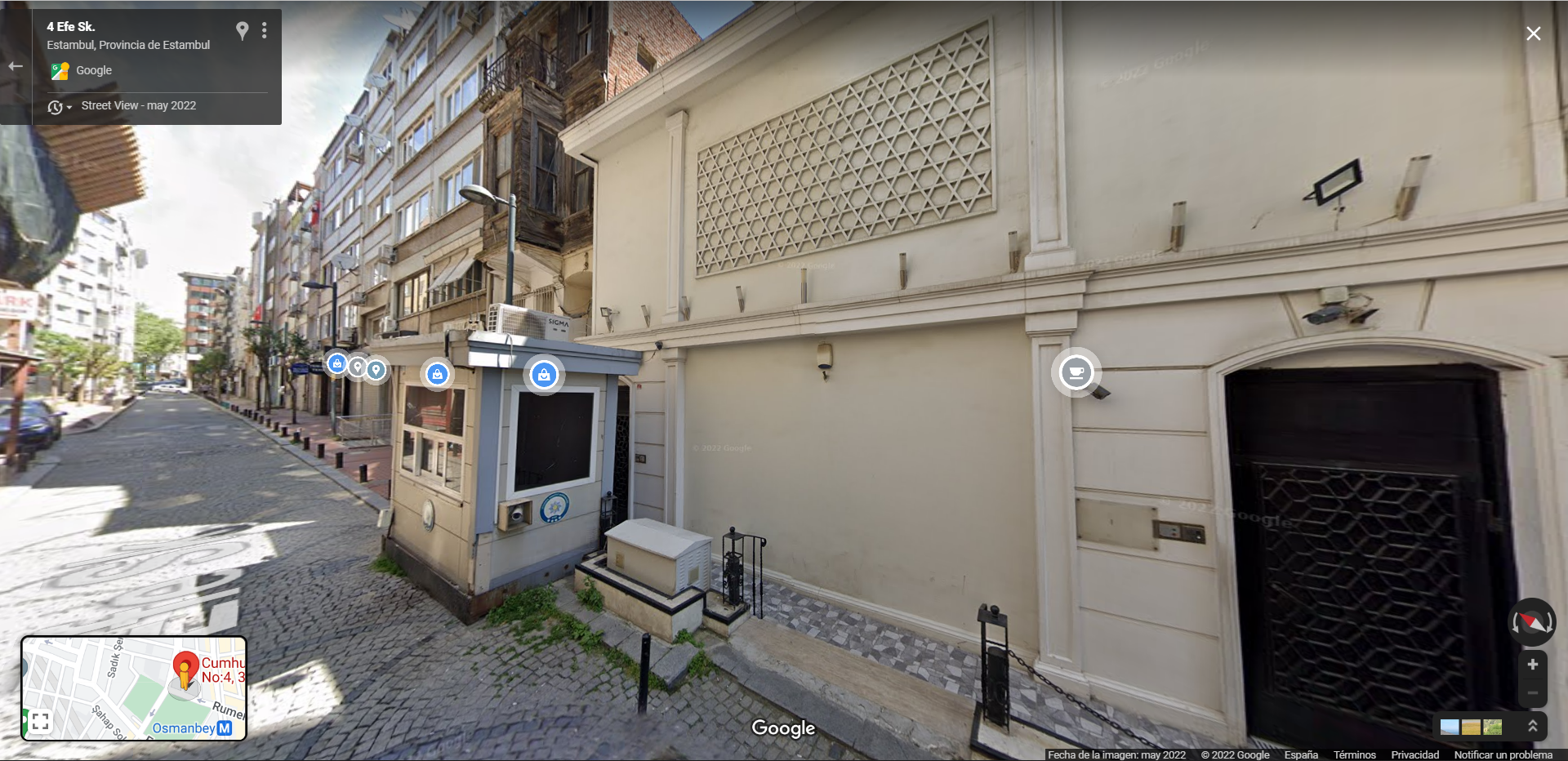8th July 2022 – Shabbat is almost here
And today we will enjoy with a piece from the repertoire of the maftirim, an art that joined Jews and Sufis
 Hello, how are you? I hope well. Today, when this letter is sent, I am in Serbia, near Novi Sad, for the conference WOMBA and the festival EXIT. It is a cloudy day and it will rain for sure. The attendance to the concerts will be a bit uncomfortable today.
Hello, how are you? I hope well. Today, when this letter is sent, I am in Serbia, near Novi Sad, for the conference WOMBA and the festival EXIT. It is a cloudy day and it will rain for sure. The attendance to the concerts will be a bit uncomfortable today.
But as I am back to you and, as promised, here you are a picture in front of the house of Abraham Senior in Segovia, where I was the previous Friday. It was a very hot and super sunny afternoon and I don’t know how my musicians could perform without melting! This house is in a very narrow street. In the picture below you see one of the entrance to the street, the “Calle Judería Vieja”, that means Street Old Jewish Quarter.
This house is currently the Didactic Center of the Jewish Quarter. If you see the map, in the same street there is a restaurant called “El fogón sefardí” (the Sephardic stove, very good restaurant, by the way, but this is common in Spain) and a pub called Gin Club Menora.

However, I am almost certain that no Jews live on those streets. As you may know, the Jews were expelled from the lands we now call Spain in 1492. And the idea that there is about the Sephardic on the part of the Spaniards is in most occasions either ignorance or a romanticized, flat and fabulated idea. The Jews who are now here, have come as emigrants, many of them from Latin America, both of Sephardic and Ashkenazi origin. According to the Federation of Jewish Communities of Spain, there are currently about 45,000 in the country. We are 47 and a half million inhabitants in total.
Part of those Jews who were expelled ended up settling in the Ottoman Empire and today we will focus on a unique music of the Jews of Turkey.
It is exciting to think that the legacy of those people lives on. In the end I’m going to look at it a little bit romantically too… I say this because today we are going to hear Sephardic music that is still alive in Istambul. It is a very special repertoire, called maftirim. I hope you’ll enjoy it!
Then, please, spread the word.
| Share this with a friend, right from here |
About the maftirim
According to eSefarad, “Maftirim is a hymn-singing tradition unique to the Turkish Jewish community, still practiced in Istanbul’s Sisli Synagogue. Most of the religious Jewish music in the Maftirim repertoire has strong connections to Ottoman court (classical) music. Many of the hymns sung in Turkey’s synagogues are precise replications of Ottoman vocal and instrumental genres such as pesrev, sarki, and beste, but with liturgical text written by different poets from the 16th century and onwards. This sacred Maftirim music utilizes many of the same aesthetics in the Ottoman makam system. The Maftirim repertoire is derived from Mevlevi dervish music, which is also divided into different makams. It is sung by men every Saturday during several months on the Jewish calendar year after the prayer ritual of the Sabbath.”
According to TurkeyTravelPlanner, the Şişli Beth Israel Synagogue “is a modern building of central importance to the present-day Jewish community of Istanbul, which is probably why it was bombed by Al Qaeda terrorists on November 15, 2003, causing terrible damage, injury, and loss of life.”

I read in Shalom.com.tr that 28 people died and 300 were injured in the attacks to this synagogue and the Neve Şalom Synagogue on 15th of November of 2003. I didn’t think I would end up talking about tragedies since this issue is about the maftirim and Lamia Yared’s terrific work, but so many times I end up finding disgraces from history…
So what are the maftirim?
I found a nice text by Ari Davidow in his oustanding Klezmershack.com about the album Maftirim (2001 Kalan Müzik) in which he explains that “the maftirim are “mystical poems sung as a prelude to the Sabbath service (or on other similar occasions). According to the liner notes, the first of these compositions were written in the 16th century by the rabbi, composer, and poet Shlomo Ben Mazaltov. “The tradition was revived in Edirne in 1696-1703 where cooperation with the Mevlevi dervishes enabled the composition of mystic hymns in more than 50 different modes and various forms.” […] Those unfamiliar with the sanctuary offered by the Ottomans to Jews after the expulsion from Spain (and prior, after the Almohades conquered Spain and introduced an intolerant strain of Islam that ended the Golden Age and drove Jews north into Christian Spain, or East) will be pleasantly surprised to find Jewish compositions in the style of the Ottoman culture–Jews integrated deeply into the surrounding and initially welcoming culture. […] The Jewish community in Istanbul, and throughout the Ottoman empire, did initially thrive. As the Ottomans lost vigor, and as the empire stagnated, religious intolerance rose. By the last century, the situation had deteriorated considerably.”. In the edition about Isak Algazi I learn that the process of turkification complicated the possibilities of development and the life quality for the Jews.
And wait a moment! Did you think I forgot to explain about “Mevlevi dervish”? No, I haven’t. Have you ever seen the whirling dervishs? According to Dar al Masnavi, “the Mevlevi Order is a traditional Islamic sufi Way (Tarîqat) that has preserved the spiritual teachings of Mawlânâ Jalâluddîn Rûmî, his descendants, successors, and followers for over 700 years.” Their whirling prayer ceremony is called Samâ`, or “Sema” in Turkish.
There is a very interesting article in Hürriyet.com.tr, about the album in which it is the recording of today, that I got to understand with an automatic translator. You can find it here and I will get some phrases:
- The story of Maftirim begins in 1492 in Edirne, one of the most important settlements for Jews who migrated from Spain to Anatolia. The Jews who immigrated to Anatolia knew Arabic music very well during the Andalusian Umayyad period. Along with the Jews who settled in Istanbul, Bursa, Edirne and Izmir, Jewish composers, instrumentalists and classical Turkish music and Sufi music soon became attached to their hearts.
- Maftirim, which was born from the interaction of Jewish mystics and Sufis in Edirne in the 16th century, was performed with Turkish Sufi music instruments in the company of Mevlevi in ancient times.
- Beginning from the 16th century, Rabbi Şelomo Ben Mazaltov, followed by the composer and Hebrew mystic İsrael Ben Moşe Nadjara (1555-1625) Avtalyon, in accordance with the maqam, style and theory of Ottoman music, and the first Maftirim songs’ foundations are laid. After the mystical hymns composed by Tanburi Izak Maftirim reaches its peak.
- In the 18th and 19th centuries, Rabbi Şemuel Mandil (1829-1883) made great contributions to the Maftirim works in Istanbul. Interaction with Turkish music breeds tolerance and good feelings in the hearts.
- Chief Rabbi Becerona Efendi (1846-1931) who prevented the extinction of the Maftirim tradition by writting the works in notes, was also a close friend of Mustafa Kemal. They met in 1910, when Mustafa Kemal was a 29-year-old young officer, and they talked for hours on language, music, literature and poetry.
About the Jews in Turkey
- The Ottoman Empire had mainly been a receiving country for Jews from all around the world. The empire’s liberal reception policies towards Jews as well as its religious tolerance towards non-Muslims made the country a choice destination for Jewish immigrants from Europe and Russia where Jews frequently suffered under severe ethno-religious oppression.The invasion of the Ottoman Empire at the end of the First World War and the beginning of the Turkish War of Independence in 1919 generated a push on emigration of non-Muslims in the Balkans and Anatolia to foreign countries which continued after the proclamation of the Turkish Republic in 1923.
- In the great wave of 1948–51, a total of 34,547 Jews – making up nearly 40 per cent of the Jewish community in Turkey at the time – emigrated from Turkey to Israel.
- Over time the number of Jews in Turkey dwindled, leaving only some 20,000–25,000 Jews in 2003 of an estimated census figure of 81,400 in 1927. Emigration was the major reason for this decline. To this day, Turkey can still be considered a sending country of Jews, as its Jewish community continues to shrink due to emigration.
So, how many Jews are nowadays in Turkey? The most recent approach I have found is from the World Jewish Congress, that mentions that: “According to the estimates of Hebrew University demographer Sergio DellaPergola’s “World Jewish Population, 2016,” Turkey is home to between 15,500 and 21,000 Jews.”
Turkey’s population is currently about 84 million.
About Hazan Aaron Kohen Yasak
About the recording of the maftir Akav Birhateha
We will listen to the version by Hazan Aaron Kohen Yasak & Maftirim İlahiler Korosu of Akav Birhateha. The ney is played by Aziz Şenol Filiz.
In the synagogue, the one who sings the maftirim is a man but you can listen to a female singer singing this piece, by the duo Senso di Voce, here. And you can listen to another version, by the Ensemble Bîrûn, here.
The piece seems to have been composed by someone called Isaac Varon but I haven’t been able to find any information about him.
The album Maftirim – Unutulan Yahudi-Sufi Geleneği was released by Kalan in 2001. According to the article from Hürriyet.com.tr, the producers got the permission of the Ministry of Culture, to meet the Contemporary Mevlana Lovers Group. “The most important feature that distinguishes the ensemble from other sema groups is that Hasan Dede broke the understanding of whirling dervish consisting of only men and added women to the community.”
This album is 21 years old and it seems that nothing else has happened in the way of recordings by the hazan or the choir.
